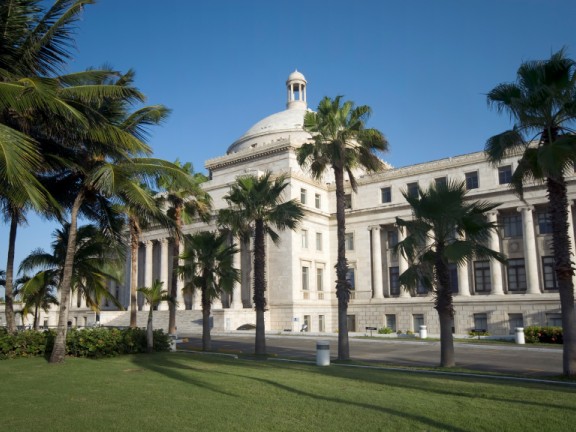Puerto Rico’s Debt Mess May Spur Solutions for High-Risk Territories

Puerto Rico is close to showing investors in the $3.7 trillion U.S. municipal bond market for the first time since the Great Depression how confusing, frustrating, and enervating life can become if a major borrower defaults and no single authority – like a federal bankruptcy court – is there to take charge and work out a deal to settle claims and get on with the business of governing.
With Puerto Rico, like all 50 U.S. states, not allowed to file for bankruptcy, the territory last month passed the Public Corporation Debt Enforcement and Recovery Act. It allows Chapter 9- or 11-style financial restructurings of debt issued by electric-power, highway and other government corporations, but not other borrowings, such as those backed by general-obligation pledges or sales-tax revenue. That is unlikely to provide immediate relief, as federal court challenges on the constitutionality of the legislation by mutual-fund managers Franklin Templeton Investments and Oppenheimer Funds Inc. will only complicate the territory’s quest to ease its unsustainable $73 billion public-debt burden and almost guarantee a legal quagmire that will take years to resolve. In that regard, both Arkansas and Argentina provide roadmaps to what may lie ahead.
It took eight years and a federal bailout to fully resolve the 1933 default on road bonds by Arkansas, still the only U.S. state to take such action on its debt in modern times. And some investors, including hedge funds, are now in their 13th year of battling Argentina after they failed to accept an offer of 30 cents on the dollar following the country’s $95 billion default in 2001. While Argentina has had the resources to support itself in the aftermath, it’s hard to see how Puerto Rico could go anywhere near that long without access to credit markets. The island territory has for years relied on borrowings to finance budget deficits and roll over maturing bonds. Its electric utility, known as Prepa, owes bondholders $8.6 billion. Standard & Poor’s says the utility also lacks the funds to repay $671 million of bank credit lines due in August, putting at risk its ability to buy fuel.
While the legal fight over Puerto Rico’s Recovery Act heats up, Pedro Pierluisi, the territory’s non-voting representative to Congress, has proposed changing the U.S. Bankruptcy Code to permit the Commonwealth’s “public agencies and instrumentalities” to file for federal court protection from creditors. But Puerto Ricans should not expect much sympathy from lawmakers for this request – or anything smacking of a federal bailout.
“Puerto Rico’s bond market struggles expose the power of its triple tax-exempt status and the extent to which investors have ignored otherwise troubling financial practices,” Municipal Market Advisors wrote in a research note July 7. “This will not be well-regarded in Congress, particularly by Republican anti-debt Tea Party representatives” who likely will cite “the island’s use of a rich subsidy for precisely the wrong reasons.”
With federal debt relief or restructuring assistance to Puerto Rico unlikely in the immediate future, investors who eagerly bought its government corporations’ debt for years had better be prepared to hunker down for a long, anxious wait should defaults occur. In the future, lenders to high-risk states and territories ineligible for U.S. bankruptcy court protection may want to insist on the same kinds of formal default-resolution frameworks and independent monitoring that international banks and governments have imposed on riskier sovereign nations as a precondition for gaining access to their credit.
That’s an imperfect solution at best, as it likely wouldn’t be able to accomplish what a bankruptcy judge can do, such as supervise the resolution of government workers’ claims for pensions and retirement benefits or address how officials can maintain vital public services. After Arkansas defaulted in 1933, “for years, infrastructure updates were all but forgotten,” the New York Times reported. “Another highway bond was not approved until 1949.” But an imperfect solution to a debt nightmare may be better to a lenders’ free-for-all no one can really control.